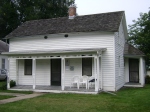
John Patrick Morgans literally wrote the book on the Underground Railroad in southern Iowa and especially Tabor, Iowa. The book is called John Todd and the Underground Railroad: A Biography of an Iowa Abolitionist. Morgans says that the Underground Railroad (UGRR) is one of the least understood stories in Iowa history. Although in Iowa we tend to think of ourselves as a northern state, the South was always very close. Cotton didn’t do well in Missouri or Kansas, but hemp did. Hemp was an incredibly important crop for making ropes, among other necessary products, and there were many slaves tasked to its production as a cash crop. Slavery could easily have spread in the Midwest.
Most of the slaves that came through Iowa were escaping from Missouri or Arkansas. Iowa was the state with the longest border with a slave state without a geographic obstacle for crossing, no rivers and no mountains. The rivers there were guided you through to Iowa and provided transportation and guidance of direction. This ease of access caused some people in Iowa, especially politicians to vote with the Southern block for fear of a widespread migration of African-Americans into Iowa.
Tabor, Iowa, was unique both in political geography and in location. Tabor served as an arms depot and training ground of sorts for Bloody Kansas. It was a stable location, but close enough to the action to be useful. In fact, even the guns that were eventually used in John Brown’s raid on Harper’s Ferry, Virginia spent 2 years hidden in Tabor. It was also close enough that the slave bounty hunters and southern men knew exactly what was going on and they lived under constant threat of being caught.
Politically Tabor was an interesting town because when it was established in 1854, the settlers were all strongly connected to the highly liberal Oberlin College. It was the most liberal college in the country at the time, allowing both men and women and blacks and whites to all attend the same classes. This liberal outlook on life meant that pretty much everyone in town was involved and supported both the Underground Railroad and the struggle to win Kansas over to the Free Soil side. Leading these efforts was Rev. John Todd.
Missouri had already been in near chaos from early rumbles of the Civil War from 1855 on. By 1860, 40,000 slaves left Missouri which was almost a third of the total population. John Brown made a final visit to Iowa in March and the attack on Harper’s Ferry came in October. During this final visit the town of Tabor, which had previously supported John Brown, turned on him for crossing a line by stealing and killing unnecessarily.
Tabor was a major site on the Underground Railroad. Tabor today is a small town. It’s laid out on the courthouse square model with a large town park in the center that was once used as a camp ground by John Brown when he visited the area. The park also was the center of the campus that once housed the college that the town’s people tried to create in the image of Oberlin, but the lack of an endowment brought the effort to an end in the first throws of the Great Depression in 1927. Today only two buildings remain as a sign of the college.

The major site in Tabor is the John Todd house. Todd was a missionary and a major leader in the efforts to support runaway slaves and the abolition of slavery in the area. It was in his cellar that John Brown’s guns waited for two years until Brown took them for his raid on Harpers

Ferry. There is a small secret room in the house, but such hiding places were generally unnecessary because there was such universal support in the town. However, bounty hunters were frequent, especially when transporting between stations.
Morgans took up a new note today talking about how the Underground Railroad Story was unknown, it was frequently misrepresented. For example, urban legends have it that the town is riddled with tunnels, but not a single tunnel as been found, even when the National Park Service brought in ground penetrating radar to look for evidence of them. However, having driven by the house and talked to the clerk at the Casey’s Store, Pulitzer Prize winning author Marilynne Robinson, described the tunnels of Tabor in her novel Gilead and then talked about her extensive research.
UPDATE 2015: I spotted a typo and fixed it. I’d also like to bring these two up from the comments section.
From Candice Floyd: “Good article except you left out the man who founded the town and enlisted John Todd to help build the settlement. George B. Gaston. He was heavily involved with the underground along with others in his family…” Gaston wasn’t included in the class as far as I remember, but I’m glad to add the information.
From Bob Dean: “Great article. Just one correction: the college back east was Oberlin College in Oberlin, Ohio. Oberlin is still an excellent four-year fully-accredited college (http://new.oberlin.edu/about/).” I had earlier fixed a mistake about the name, but I thought his point that the college that inspired Tabor out east still exists was worth sharing.
Sarah S. Uthoff is the main force behind Trundlebed Tales fighting to bring the History, Mystery, Magic and Imagination of Laura Ingalls Wilder and other greats of children’s literature and history to life for a new generation.Attend one of her programs, schedule one yourself, watch her videos, listen to her podcast, and find her on Facebook, Twitter, Google+,LinkedIn, and Academia.edu. She is currently acting President of the Laura Ingalls Wilder Legacy and Research Association. Professionally she is a reference librarian at Kirkwood Community College and director of the Oxford (Iowa) Public Library.

Thanks for this excellent historical information.
LikeLike
Great article. Just one correction: the college back east was Oberlin College in Oberlin, Ohio. Oberlin is still an excellent four-year fully-accredited college (http://new.oberlin.edu/about/).
LikeLike
Thank you for pointing that out. Not sure what was going on when I wrote it because I had it right twice and wrong twice, but I corrected it throughout now. It’s odd because normally I re-read stuff like this after it was published, but I still didn’t catch it.
LikeLike
You are welcome, and thank you for the wonderful article. Am relatively new to southwest Iowa, so hope to visit our URR and Civil War – related sites. That’s why I ran across your blog. Thanks again!
LikeLike
Good article except you left out the man who founded the town and enlisted John Todd to help build the setttlement. George B. Gaston. He was heavily involved with the underground along with others in his family..
LikeLike
Reblogged this on Sarah’s Notebook and commented:
No real update for this post, except be sure to read the comments. Some readers have added some interesting information since it was originally published. It’s one of the most commented on posts.
LikeLike